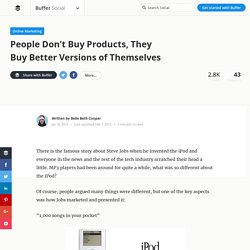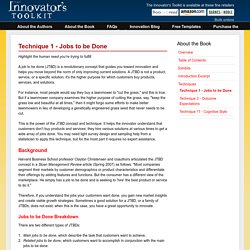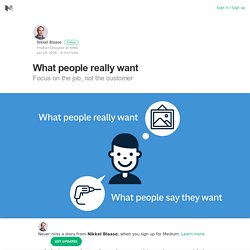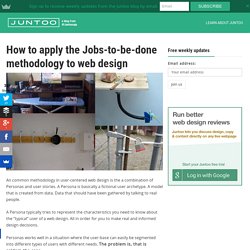

Achieve Product-Market Fit with our Brand-New Value Proposition Designer Canvas. I’m a big fan of the Lean Startup movement and love the underlying principle of testing, learning, and pivoting by experimenting with the most basic product prototypes imaginable - so-called Minimal Viable Products (MVP) – during the search for product-market fit.

It helps companies avoid building stuff that customers don’t want. Yet, there is no underlying conceptual tool that accompanies this process. There is no practical tool that helps business people map, think through, discuss, test, and pivot their company’s value proposition in relationship to their customers’ needs. So I came up with the Value Proposition Designer Canvas together with Yves Pigneur and Alan Smith. The Value Proposition Designer Canvas is like a plug-in tool to the Business Model Canvas. The Canvas with its 9 building blocks focuses on the big picture. In this post I’ll explain the conceptual tool. Replacing The User Story With The Job Story – Jobs to be Done. 5 Tips For Writing A Job Story – Jobs to be Done. What Is Insight? The 5 Principles of Insight Definition - Thrive. As customer experiences take center stage so does the need for more profound and compelling insight definition.
Insights form the cornerstone of the design and innovation process, a lighthouse for what you should do next, and a catalyst for creating new value for your customers. The ever-increasing explosion of data puts more knowledge at our fingertips than ever before, but you need to know what to do with it. Otherwise, it is obsolete and ineffective. We see an increasing lack of insight with companies living in an “illusion of knowledge,” drowning in data, insight poor, and failing to turn information into intelligence.
Why? The lack of shared understanding of what an insight is, and is not is one reason. What An Insight Is Not ‘Insight’ has become a horribly misused word, much in the same vein as ‘brand,’ ‘strategy’ and ‘innovation’ have become misused words. Insight is not data Data can take many forms, but we have to remember it is just that — data! People Don't Buy Products, They Buy Better Versions of Themselves. There is the famous story about Steve Jobs when he invented the iPod and everyone in the news and the rest of the tech industry scratched their head a little.

MP3 players had been around for quite a while, what was so different about the iPod? Of course, people argued many things were different, but one of the key aspects was how Jobs marketed and presented it: “1,000 songs in your pocket” When everyone else was saying “1GB storage on your MP3 player”, telling people about the product, Apple went ahead and made you a better person, that has 1000 songs in your pocket. Our friends over at User Onboarding wrote an incredible post and graphic, showcasing how this framework looks on a higher level: Note: Try sharing the above image by right-clicking it and the choosing “add to Buffer” with the Buffer browser extension, it’s one of our most shared updates, ever In particular, the image itself proved to be popular—understandably. Value_proposition_canvas.pdf. Technique 1 - Jobs to be Done.
Highlight the human need you're trying to fulfill.

A job to be done (JTBD) is a revolutionary concept that guides you toward innovation and helps you move beyond the norm of only improving current solutions. A JTBD is not a product, service, or a specific solution; it's the higher purpose for which customers buy products, services, and solutions. For instance, most people would say they buy a lawnmower to "cut the grass," and this is true.
But if a lawnmower company examines the higher purpose of cutting the grass, say, "keep the grass low and beautiful at all times," then it might forgo some efforts to make better lawnmowers in lieu of developing a genetically engineered grass seed that never needs to be cut. What people really want – Nikkel Blaase – Medium. Jobs, not users Creating remarkable products does not come from understanding typical customers.

Products must serve core needs, not what people say they want. We should think less about archetypal customers and more about the jobs people want to get done. Customers’ behavior must be observed rather than inquired. Instead of putting fictional Personas, based on common denominators, into the center of design research, we should focus on the jobs people hire the product for.
The forces at work when choosing a product. The jobs-to-be-done framework isn’t new, but I’ve only recently started digging into it much more since it’s been gaining a lot of traction everywhere I look.

For a nice primer on the topic see Eric Portelance’s recent article for Teehan+Lax called The Iceberg of Jobs-to-be-Done, in which he explains how crucial this framework is for good product design: [Most successful products are created by] people who understand the importance of creating products that solve real customer problems, and have a set of tools and frameworks like jobs-to-be-done that they use to identify and validate the real human problems they’re trying to solve in the market. The progress-making forces diagram has been particularly useful for me in client work, since it helps people understand how difficult it can be to change existing user behavior.
A Ridiculously Simple Tool For Building Products People Love (fastcodesign.com) – samuelbausson's highlights. How to apply the Jobs-to-be-done methodology to web design. An common methodology in user-centered web design is the a combination of Personas and user stories.

A Persona is basically a fictional user archetype. A model that is created from data. Data that should have been gathered by talking to real people. Au @MuseeLouvre on est bien □